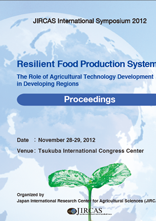Climate Change and Flood Risk in the Mekong Delta ? Adaptation and Coexistence in Flood-Prone Rice Area

Introduction
Vietnam is the world’s second largest rice exporter, with 90% of rice exports produced in the Mekong
Delta region. However, it is being threatened by sea level rise and river flooding. According to the Fourth
Assessment Report of the Intergovernmental Panel on Climate Change (IPCC), the densely populated
mega deltas in South and Southeast Asia face the greatest risk. To address the report, the government of
Vietnam formulated a National Target Program in 2008 to respond to climate change. In it, they
acknowledged the need to cope with three key issues?saltwater intrusion, flooding, and lack of fresh
water?as soon as possible. Mekong Delta, whose floodwaters enter Vietnam from Cambodia, is located
in a vast network of distributaries at the mouth of Mekong River. Riverine and tidal floods are common,
reaching even the upper Mekong Delta plain (inundation levels between 1-3 m). Nevertheless, the area
remains active as a rice granary due to its nutrient-rich soils and dense waterways and canals.
Two types of dyke systems were constructed to reduce vulnerability in high-flood areas such as An
Giang and Dong Thap Provinces adjacent to the Cambodian border: a high embankment called “fulldyke”,
which completely prevents farmland from flooding; and a low embankment called “semi-dyke”,
which prevents flooding up to the summer-autumn rice harvest but allows flood inflow after harvest. Triple rice cropping became possible in farmlands enclosed by full-dykes as rice can be grown even
during peak flood season (September to November). In response to farmers’ request, the Vietnamese
government made it a policy to construct dykes, hence areas with full-dyke systems expanded rapidly in
the past 10 years especially in An Giang and Dong Thap. However, negative impacts caused by preventing
floodwater into the farmland and by employing a triple rice cropping system soon became apparent. The
current state of the full-dyke system in a flood-prone rice granary area in Mekong Delta is discussed in this
article, based on a survey conducted in An Giang where a JIRCAS climate change project is located. Advantages and disadvantages of full-dyke systems
The first full-dyke in Chau Phu District in An Giang Province was built in 2001 on a small sandbar
along Mekong River, but it was only in 2006 when full-dyke systems began to expand rapidly. Areas
covered by full-dyke systems increased from only around 20% in 2007 to more than 80% by 2011.
There are several advantages and disadvantages of full-dyke systems. Full-dykes protect farmlands
from floods throughout the year, allowing farmers to grow and harvest rice up to three times a year.
However, it has also been documented that full-dykes have many disadvantages. The scale of the large flood that occurred along Mekong River in 2011, which caused many full-dykes in An Giang
Province to burst, was a scale comparable to that in 2000. The upper part of Photo 2 shows the inundated
area in Chau Phu District in An Giang caused by the collapse of the full-dyke in 2011. The full-dyke was
built in 2010 but was destroyed by flood the following year. The damaged area was approximately 110 ha.
The collapsed dyke has been repaired by the local government, but the full-dyke system was found to have
safety problems. Summary
Sea level rise and increased flood frequencies have been attributed to climate change caused by global
warming. The highly-productive ricelands of the Mekong Delta Region are among those affected by these
phenomena. Lately, deeper floods lasting over longer periods have affected rice cultivation, raising
concerns about the future of rice production. Construction of full-dykes progressed rapidly during the past
decade, expanding triple rice cropping in the region. The system increased rice production in the area but
it also prevented the nutrients normally carried by floodwater from reaching the farms, resulting to an
obvious decline in soil fertility and an increase in pest population. Because of this, chemical fertilizers and
pesticides became widely used, which in turn deteriorated water quality in full-dyke areas. Clearly, there
is a need to establish a sustainable dyke system that reduces flood risk while maintaining riceland
productivity in flood-prone rice areas in Mekong Delta.
| Date of issued | |
|---|---|
| Creator | Hideto Fujii |
| Subject |
Adaptation to Climate Change Mekong Delta Flood-prone area Triple rice Full-dyke system |
| Publisher | Japan International Research Center for Agricultural Sciences |
| Available Online | |
| Issue | 2012 |
| spage | 151 |
| epage | 161 |
| Rights | Japan International Research Center for Agricultural Sciences |
| Language | eng |
